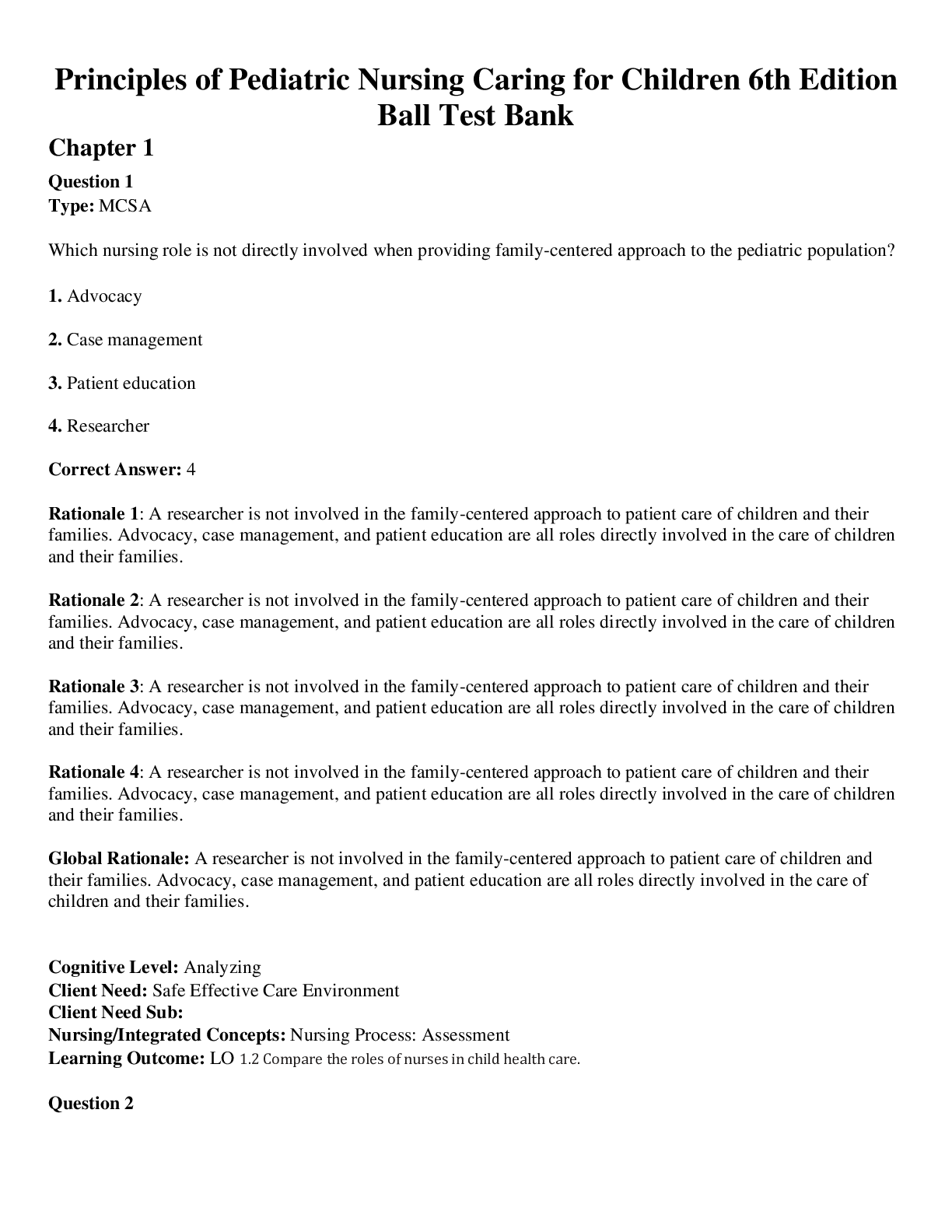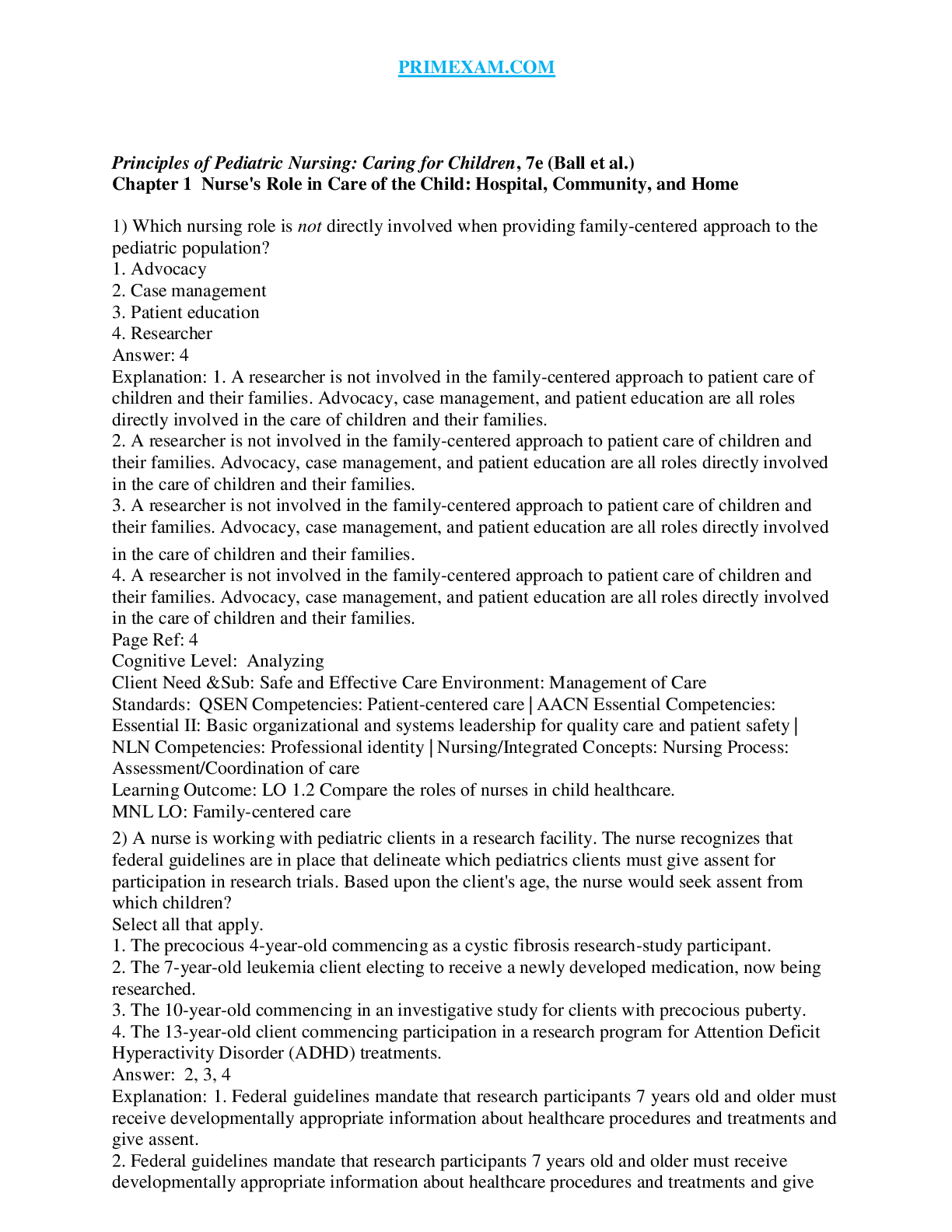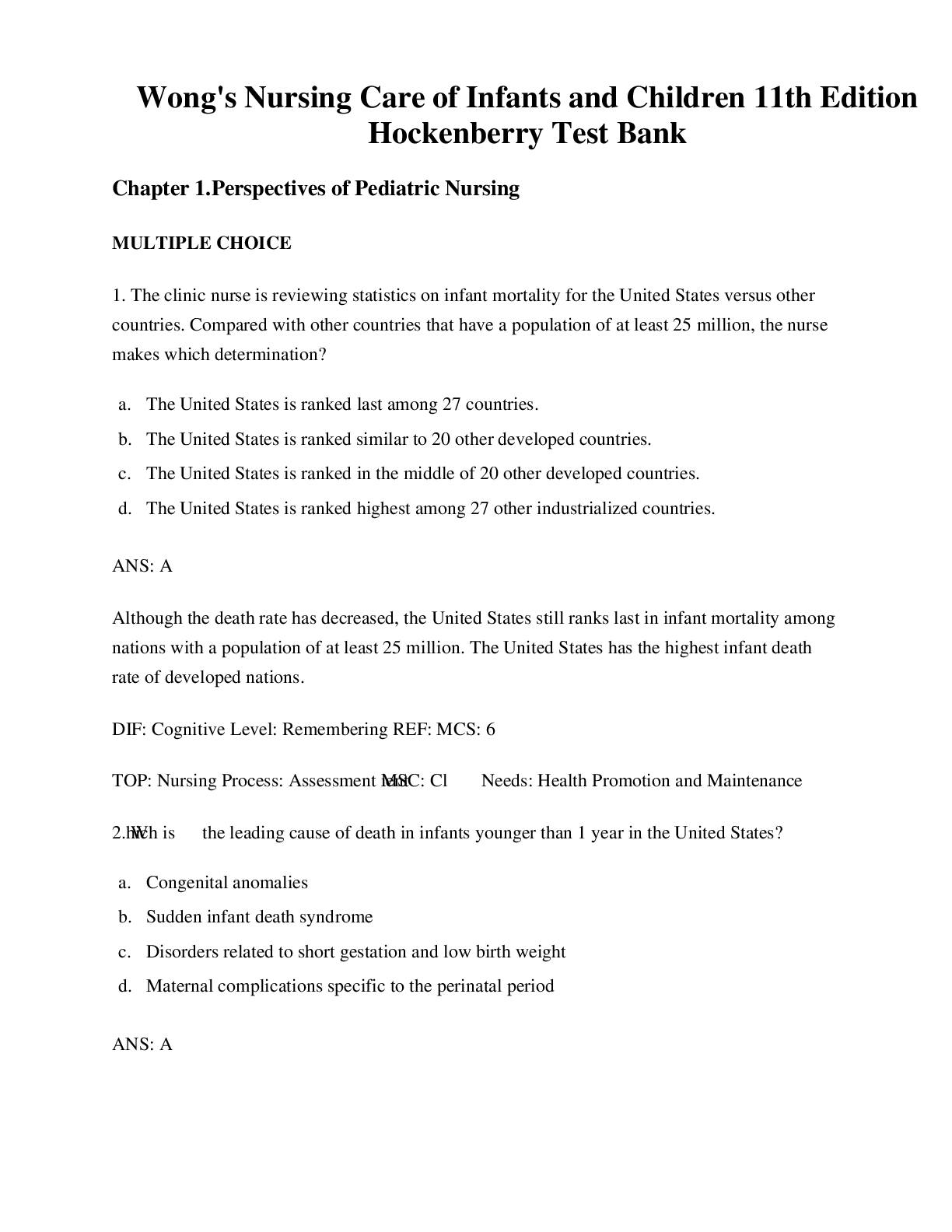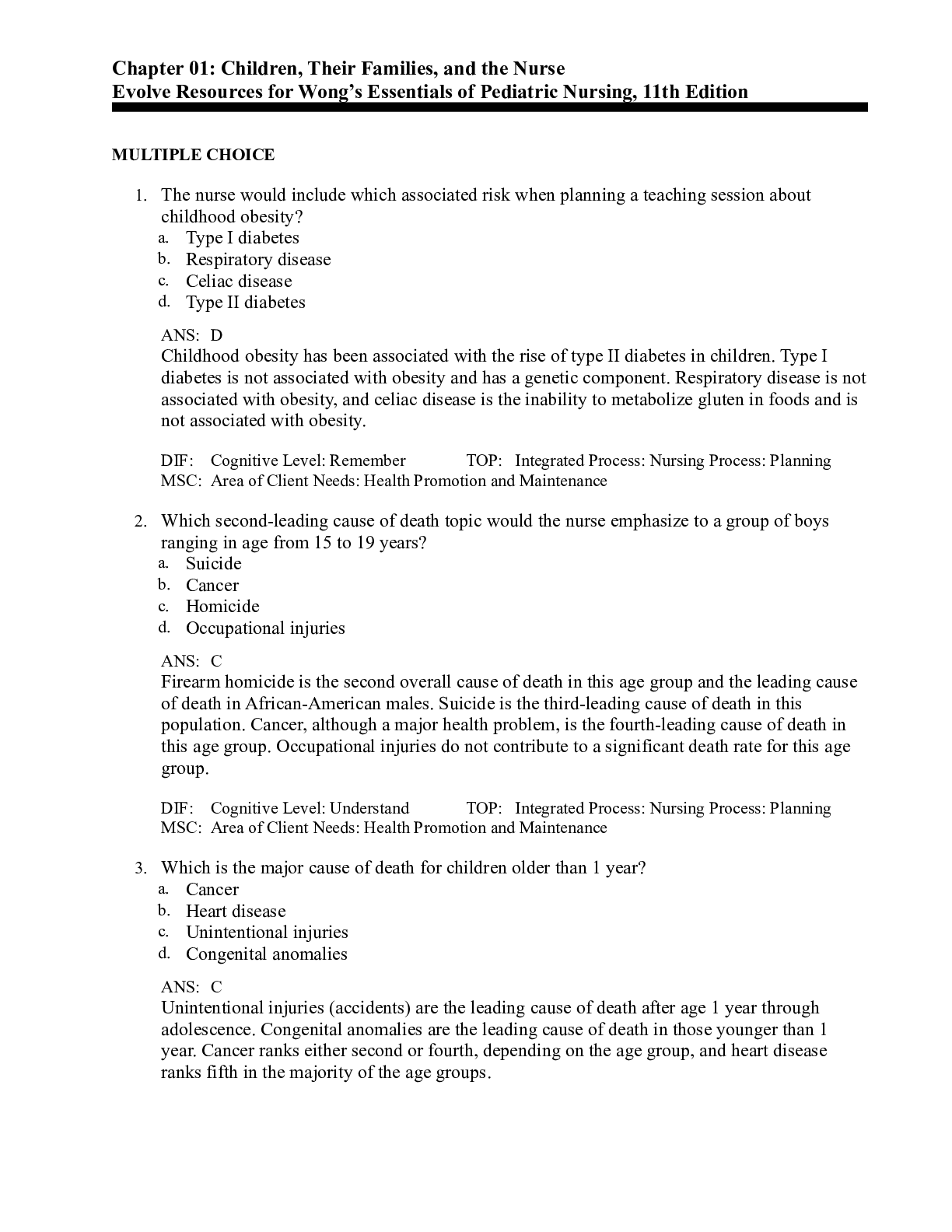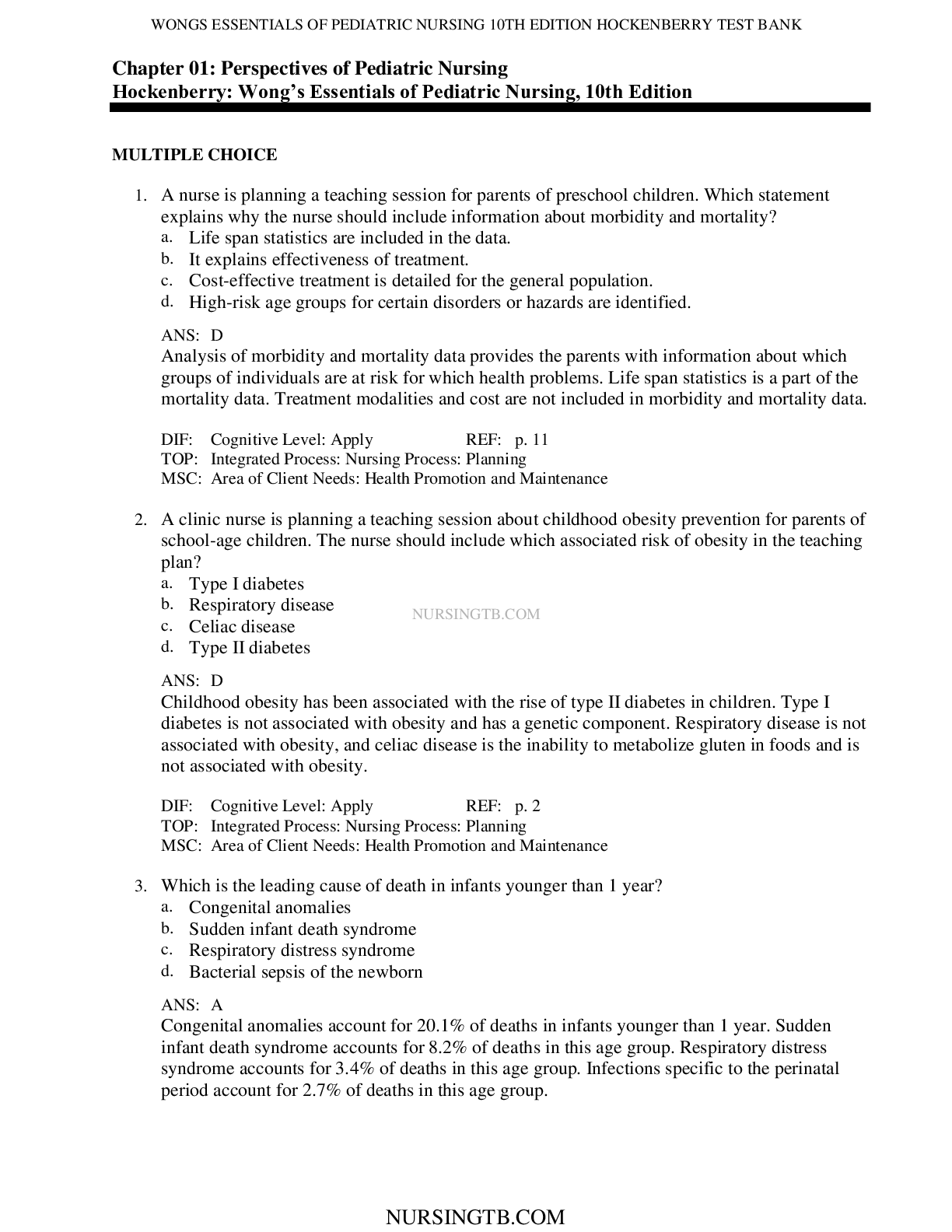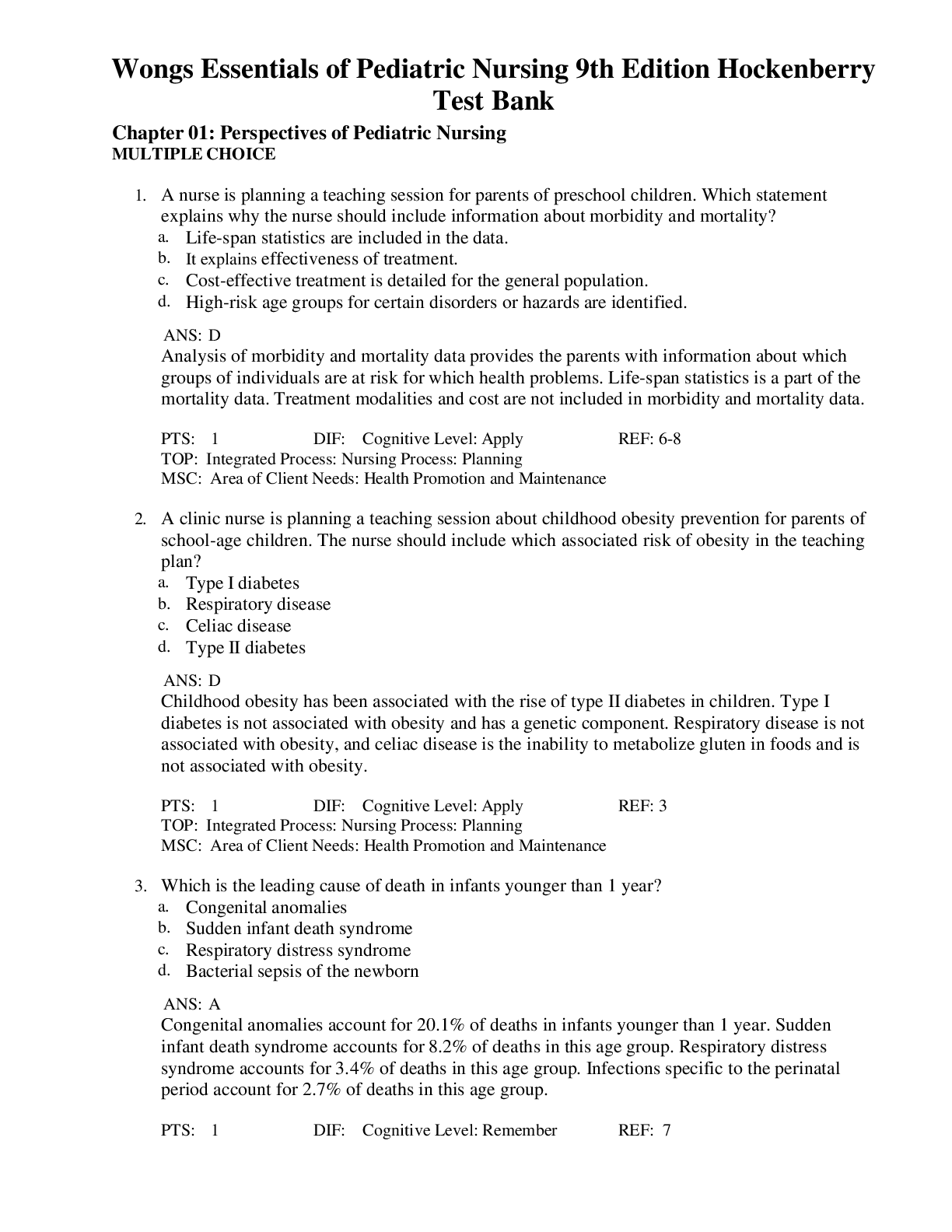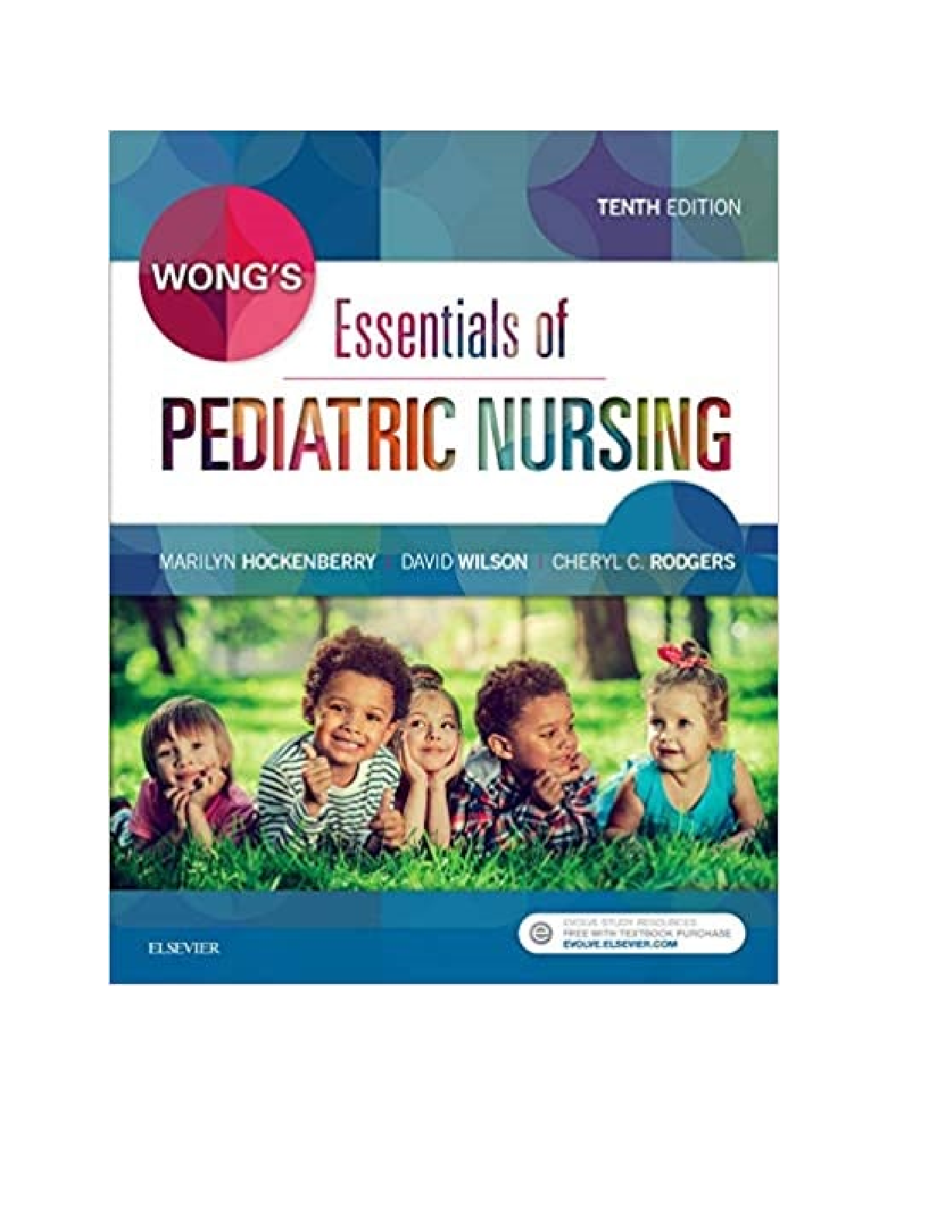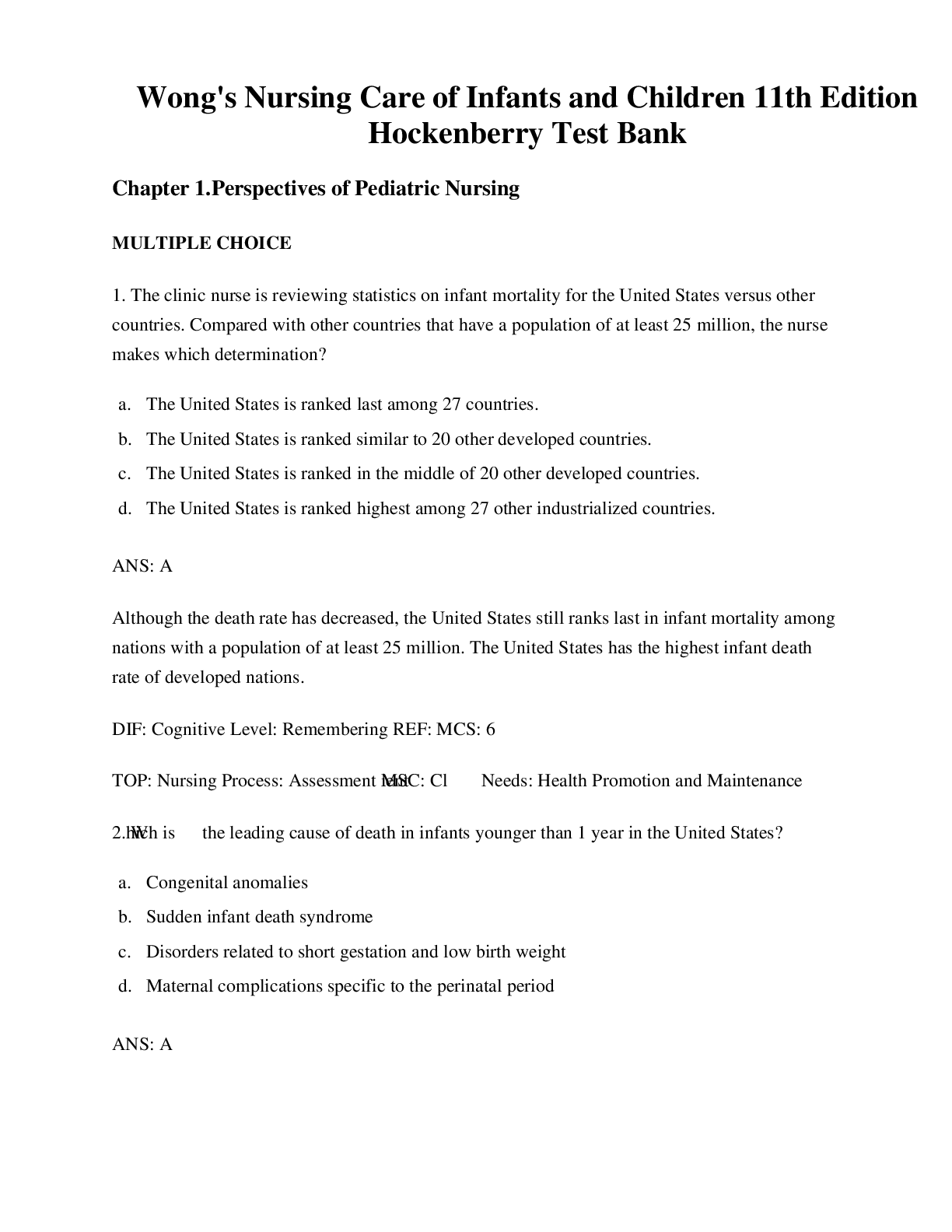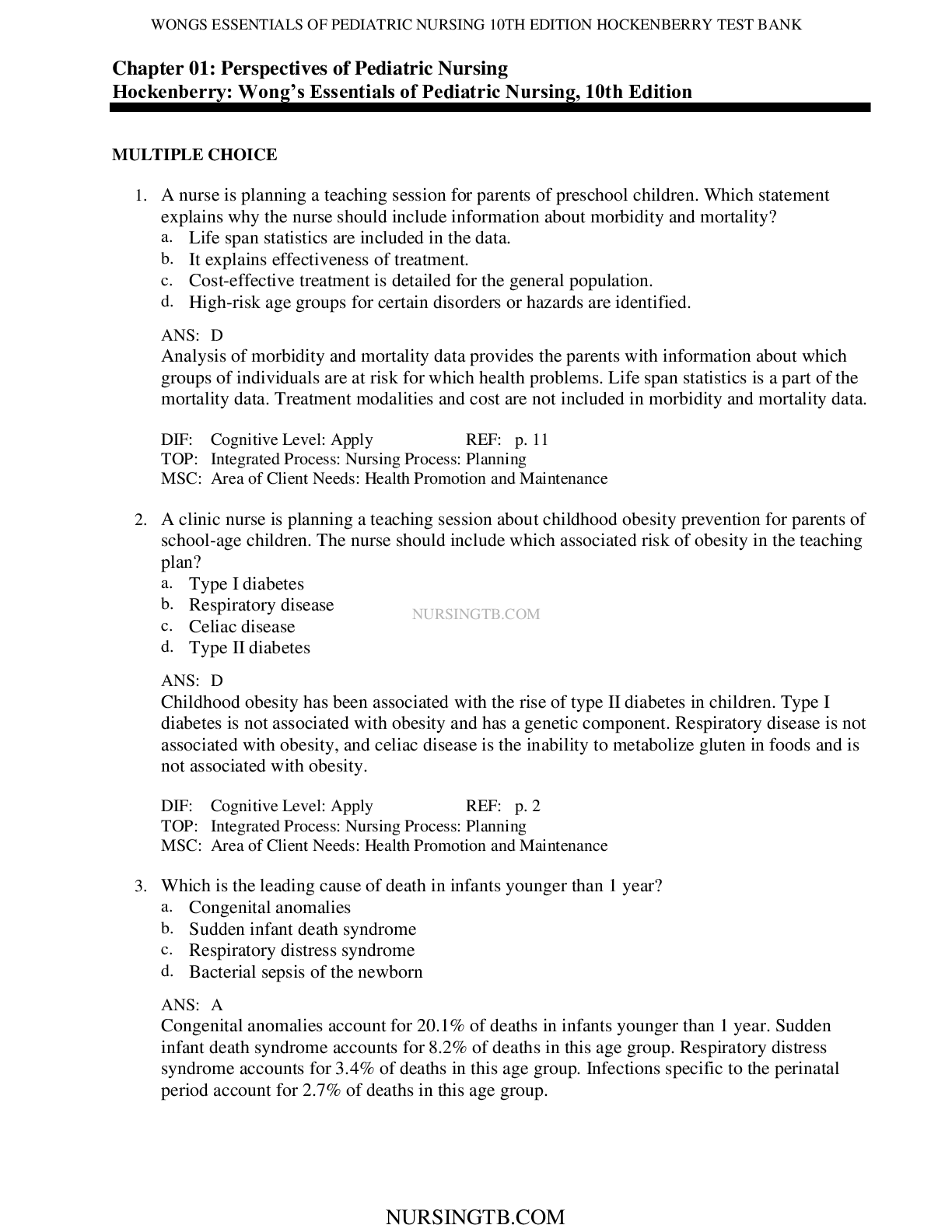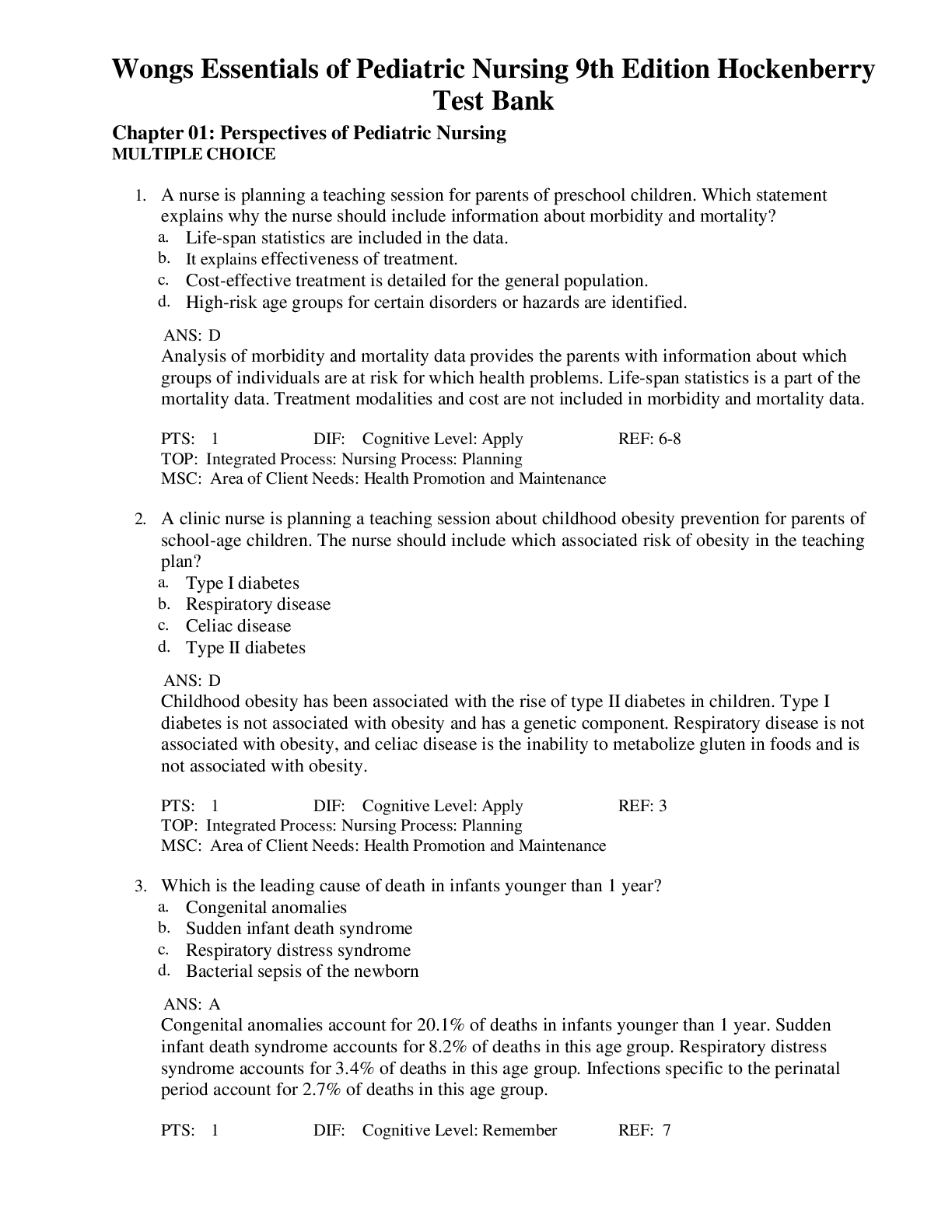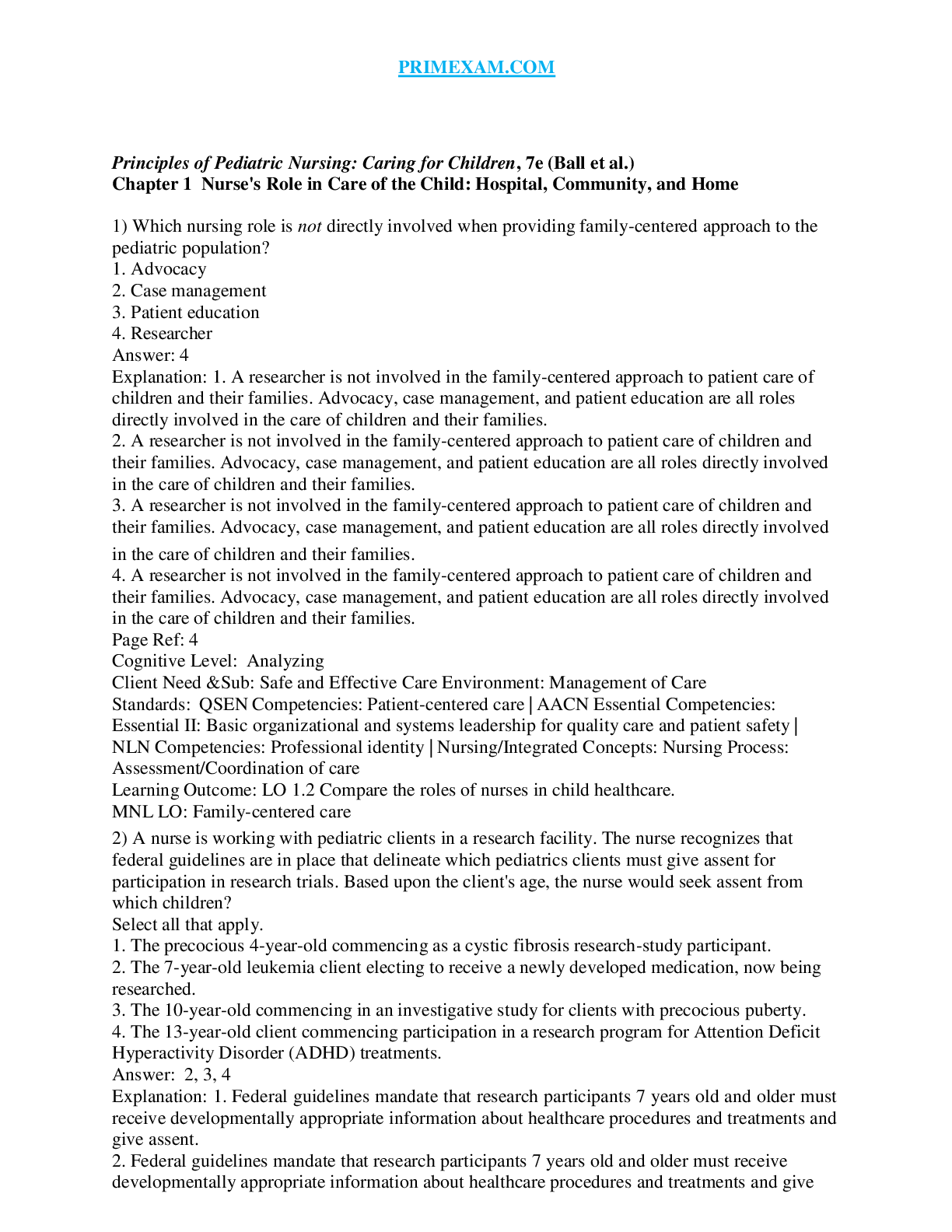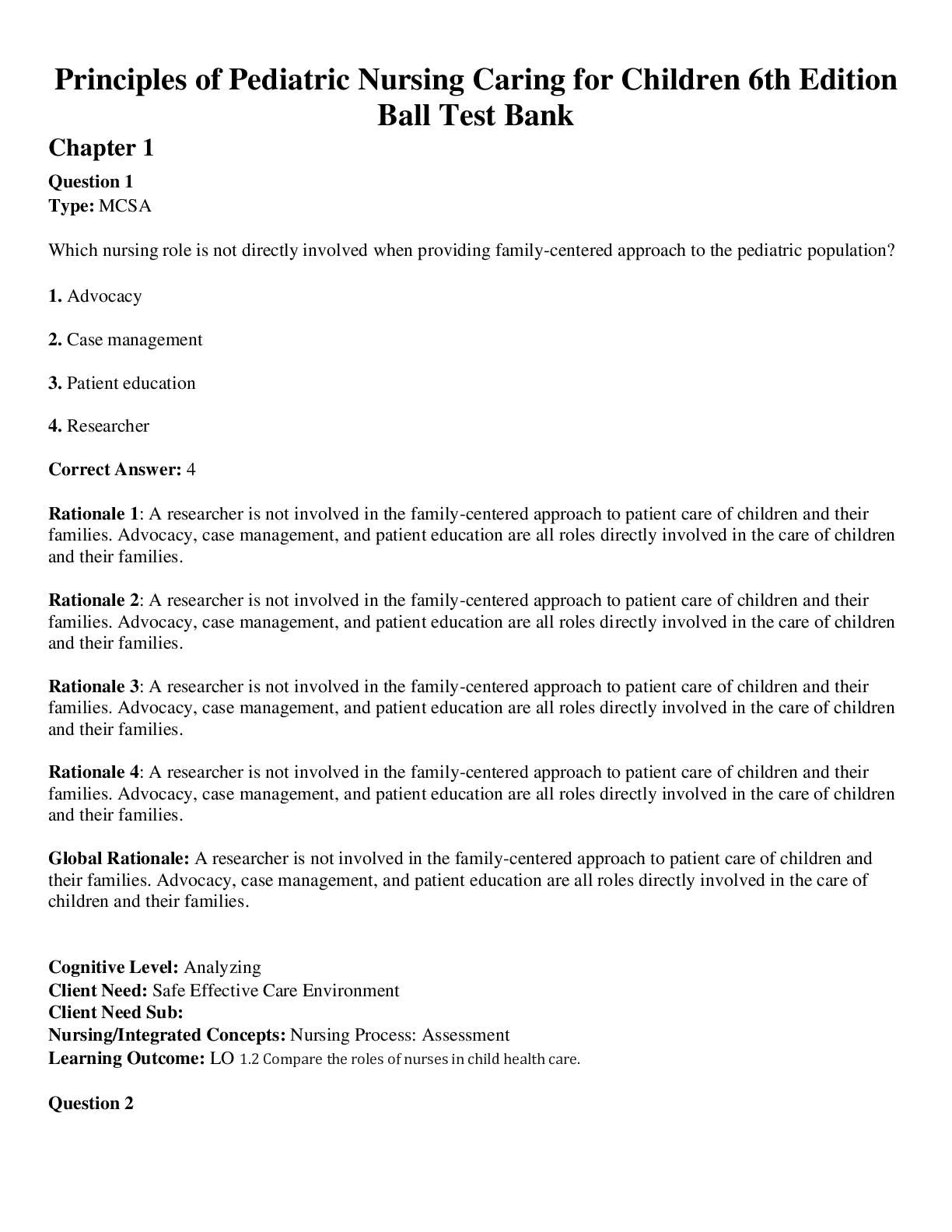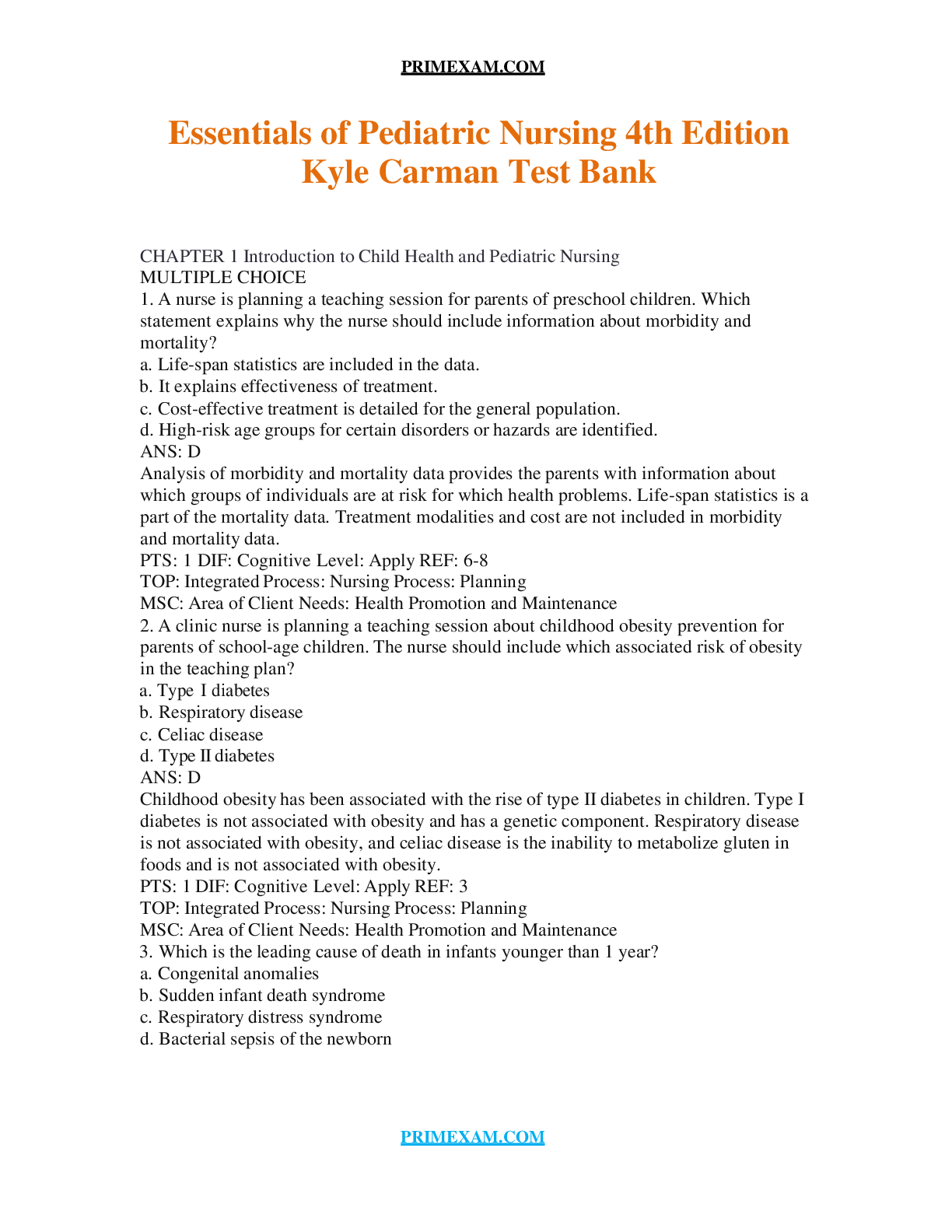*NURSING > TEST BANK > Wong’s Essentials of Pediatric Nursing 11th Edition Hockenberry Rodgers Wilson Test Bank (All)
Wong’s Essentials of Pediatric Nursing 11th Edition Hockenberry Rodgers Wilson Test Bank
Document Content and Description Below
Table of Contents Table of Contents Chapter 01: Perspectives of Pediatric Nursing Chapter 02: Social, Cultural, Religious, and Family Influences on Child Health Promotion Chapter 03: Hereditary In... fluences on Health Promotion of the Child and Family Chapter 04: Communication, Physical, and Developmental Assessment of the Child and Family Chapter 05: Pain Assessment and Management in Children Chapter 06: Childhood Communicable and Infectious Diseases Chapter 07: Health Promotion of the Newborn and Family Chapter 08: Health Problems of the Newborn Chapter 09: The High-Risk Newborn and Family Chapter 10: Health Promotion of the Infant and Family Chapter 11: Health Problems of the Infant Chapter 12: Health Promotion of the Toddler and Family Chapter 13: Health Promotion of the Preschooler and Family Chapter 14: Health Problems of Early Childhood Chapter 15: Health Promotion of the School-Age Child and Family Chapter 16: Health Problems of the School-Age Child Chapter 17: Health Promotion of the Adolescent and Family Chapter 18: Health Problems of the Adolescent Chapter 19: Family-Centered Care of the Child with Chronic Illness or Disability Chapter 20: Family-Centered Palliative Care Chapter 20: Impact of Cognitive or Sensory Impairment on the Child and Family Chapter 21: Family-Centered Care of the Child During Illness and Hospitalization Chapter 22: Pediatric Nursing Interventions and Skills Chapter 23: The Child with Fluid and Electrolyte Imbalance Chapter 24: The Child with Renal Dysfunction Chapter 25: The Child with Gastrointestinal Dysfunction Chapter 26: The Child with Respiratory Dysfunction Chapter 27: The Child with Cardiovascular Dysfunction Chapter 28: The Child with Hematologic or Immunologic Dysfunction Chapter 29: The Child with Cancer Chapter 30: The Child with Cerebral Dysfunction Chapter 31: The Child with Endocrine Dysfunction Chapter 32: The Child with Integumentary Dysfunction Chapter 33: The Child with Musculoskeletal or Articular Dysfunction Chapter 34: The Child with Neuromuscular or Muscular Dysfunction Test Bank - Wong's Nursing Care of Infants and Children (11e by Hockenberry) 1 Chapter 01: Perspectives of Pediatric Nursing MULTIPLE CHOICE 1. The clinic nurse is reviewing statistics on infant mortality for the United States versus other countries. Compared with other countries that have a population of at least 25 million, the nurse makes which determination? a. The United States is ranked last among 27 countries. b. The United States is ranked similar to 20 other developed countries. c. The United States is ranked in the middle of 20 other developed countries. d. The United States is ranked highest among 27 other industrialized countries. ANS: A Although the death rate has decreased, the United States still ranks last in infant mortality among nations with a population of at least 25 million. The United States has the highest infant death rate of developed nations. DIF: Cognitive Level: Remembering TOP: Nursing Process: Assessment MSC: Client Needs: Health Promotion and Maintenance 2. Which is the leading cause of death in infants younger than 1 year in the United States? a. Congenital anomalies b. Sudden infant death syndrome c. Disorders related to short gestation and low birth weight d. Maternal complications specific to the perinatal period ANS: A Congenital anomalies account for 20.1% of deaths in infants younger than 1 year compared with sudden infant death syndrome, which accounts for 8.2%; disorders related to short gestation and unspecified low birth weight, which account for 16.5%; and maternal complications such as infections specific to the perinatal period, which account for 6.1% of deaths in infants younger than 1 year of age. DIF: Cognitive Level: Remembering MSC: Client Needs: Health Promotion and Maintenance 3. What is the major cause of death for children older than 1 year in the United States? a. Heart disease Test Bank - Wong's Nursing Care of Infants and Children (11e by Hockenberry) 2 b. Childhood cancer c. Unintentional injuries d. Congenital anomalies ANS: C Unintentional injuries (accidents) are the leading cause of death after age 1 year through adolescence. The leading cause of death for those younger than 1 year is congenital anomalies, and childhood cancers and heart disease cause a significantly lower percentage of deaths in children older than 1 year of age. DIF: Cognitive Level: Understanding MSC: Client Needs: Health Promotion and Maintenance 4. In addition to injuries, what are the leading causes of death in adolescents ages 15 to 19 years? a. Suicide and cancer b. Suicide and homicide c. Drowning and cancer d. Homicide and heart disease ANS: B Suicide and homicide account for 16.7% of deaths in this age group. Suicide and cancer account for 10.9% of deaths, heart disease and cancer account for approximately 5.5%, and homicide and heart disease account for 10.9% of the deaths in this age group. DIF: Cognitive Level: Remembering MSC: Client Needs: Health Promotion and Maintenance 5. The nurse is planning a teaching session to adolescents about deaths by unintentional injuries. Which should the nurse include in the session with regard to deaths caused by injuries? a. More deaths occur in males. b. More deaths occur in females. c. The pattern of deaths does not vary according to age and sex. d. The pattern of deaths does not vary widely among different ethnic groups. ANS: A The majority of deaths from unintentional injuries occur in males. The pattern of death does vary greatly Test Bank - Wong's Nursing Care of Infants and Children (11e by Hockenberry) 3 among different ethnic groups, and the causes of unintentional deaths vary with age and gender. DIF: Cognitive Level: Applying TOP: Integrated Process: Teaching/Learning MSC: Client Needs: Health Promotion and Maintenance 6. What do mortality statistics describe? a. Disease occurring regularly within a geographic location b. The number of individuals who have died over a specific period c. The prevalence of specific illness in the population at a particular time d. Disease occurring in more than the number of expected cases in a community ANS: B Mortality statistics refer to the number of individuals who have died over a specific period. Morbidity statistics show the prevalence of specific illness in the population at a particular time. Data regarding disease within a geographic region, or in greater than expected numbers in a community, may be extrapolated from analyzing the morbidity statistics. DIF: Cognitive Level: Remembering MSC: Client Needs: Health Promotion and Maintenance 7. The nurse should assess which age group for suicide ideation since suicide in which age group is the third leading cause of death? a. Preschoolers b. Young school age c. Middle school age d. Late school age and adolescents ANS: D Suicide is the third leading cause of death in children ages 10 to 19 years; therefore, the age group should be late school age and adolescents. Suicide is not one of the leading causes of death for preschool and young or middle school-aged children. DIF: Cognitive Level: Understanding TOP: Nursing Process: Assessment MSC: Client Needs: Health Promotion and Maintenance 8. Parents of a hospitalized toddler ask the nurse, What is meant by family-centered care? The nurse should respond with which statement? Test Bank - Wong's Nursing Care of Infants and Children (11e by Hockenberry) 4 a. Family-centered care reduces the effect of cultural diversity on the family. b. Family-centered care encourages family dependence on the health care system. c. Family-centered care recognizes that the family is the constant in a childs life. d. Family-centered care avoids expecting families to be part of the decision-making process. ANS: C The three key components of family-centered care are respect, collaboration, and support. Family-centered care recognizes the family as the constant in the childs life. The family should be enabled and empowered to work with the health care system and is expected to be part of the decision-making process. The nurse should also support the familys cultural diversity, not reduce its effect. DIF: Cognitive Level: Applying TOP: Nursing Process: Implementation MSC: Client Needs: Health Promotion and Maintenance 9. The nurse is describing clinical reasoning to a group of nursing students. Which is most descriptive of clinical reasoning? a. Purposeful and goal directed b. A simple developmental process c. Based on deliberate and irrational thought d. Assists individuals in guessing what is most appropriate ANS: A Clinical reasoning is a complex developmental process based on rational and d [Show More]
Last updated: 1 year ago
Preview 1 out of 803 pages
Instant download
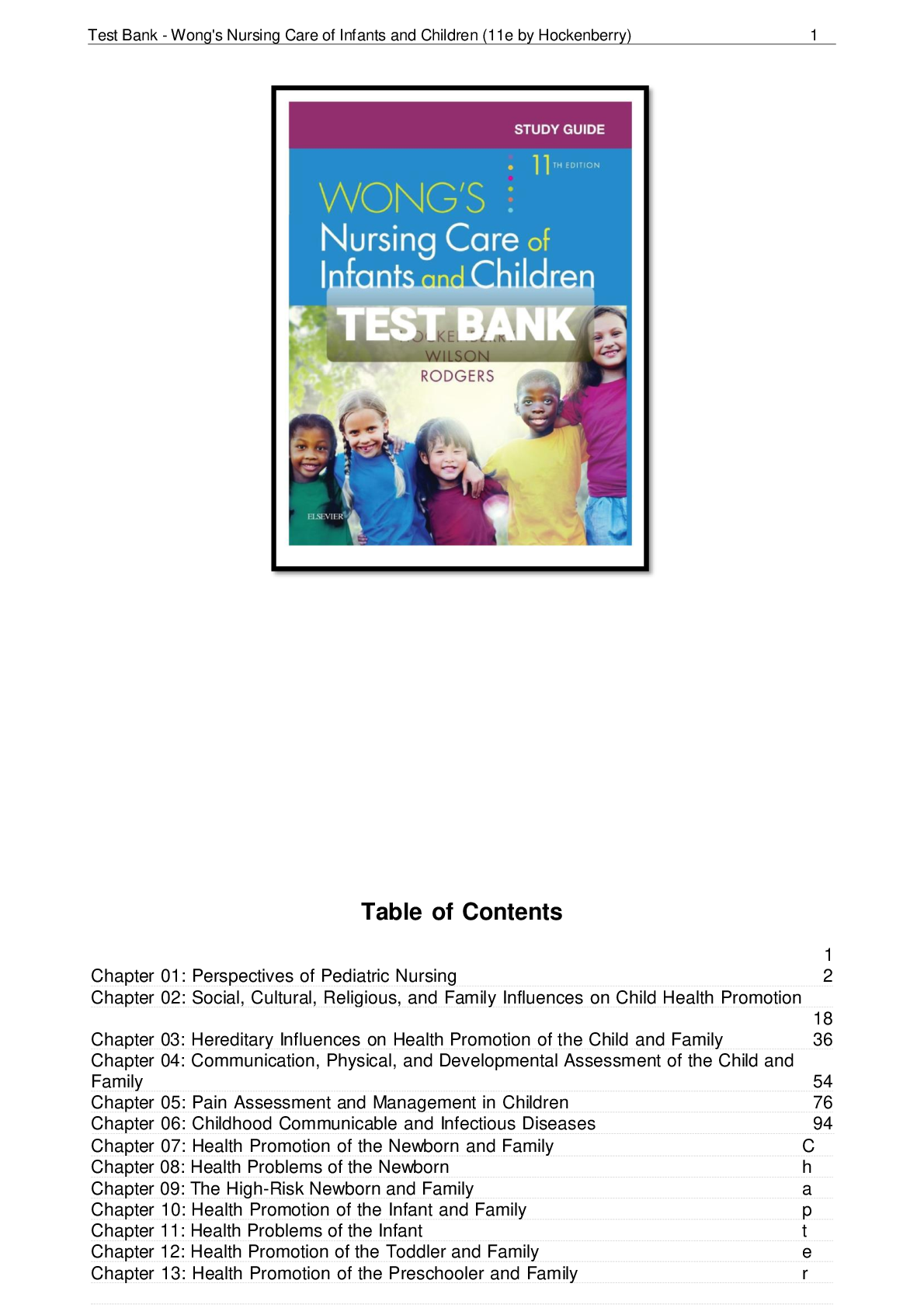
Instant download
Reviews( 0 )
Document information
Connected school, study & course
About the document
Uploaded On
Oct 21, 2021
Number of pages
803
Written in
Additional information
This document has been written for:
Uploaded
Oct 21, 2021
Downloads
0
Views
68

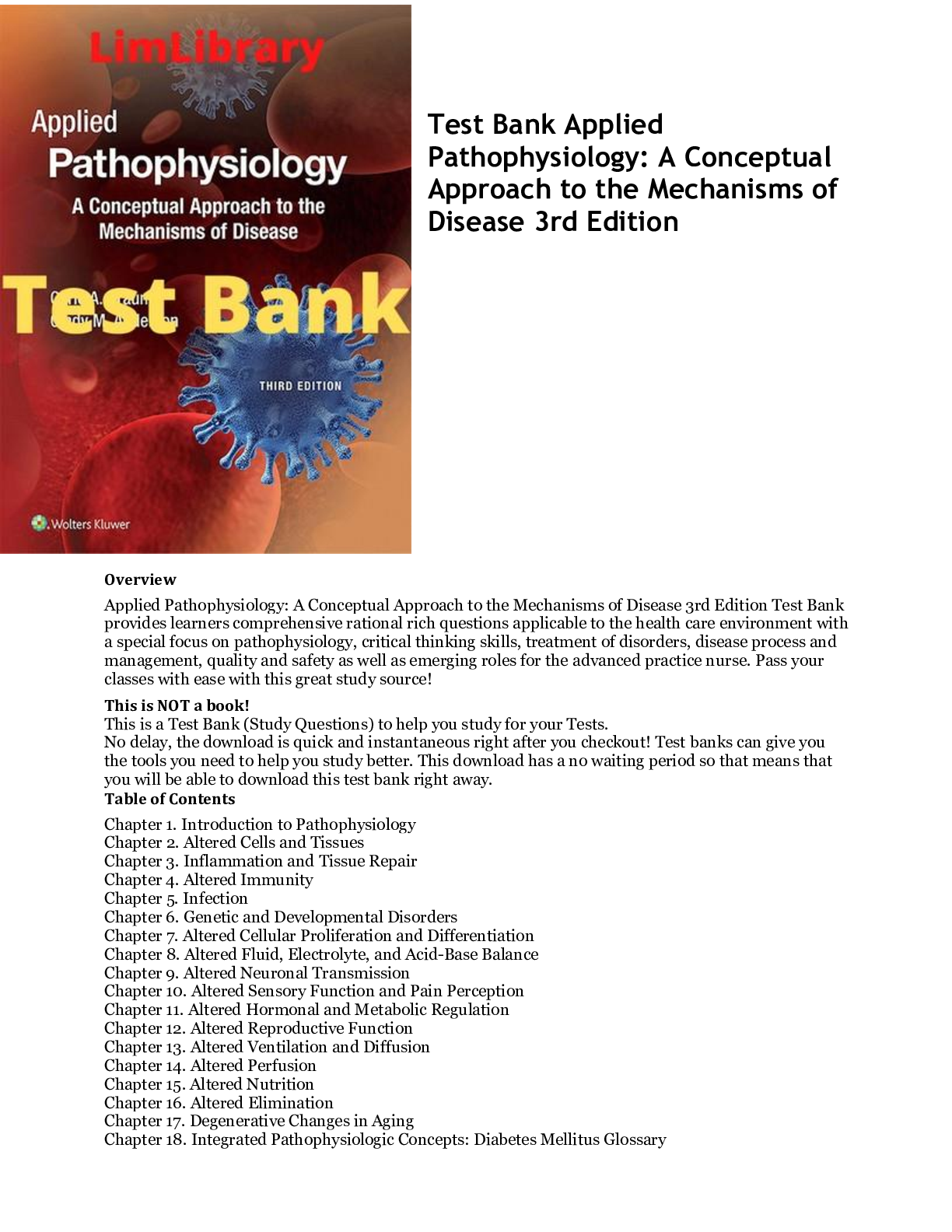

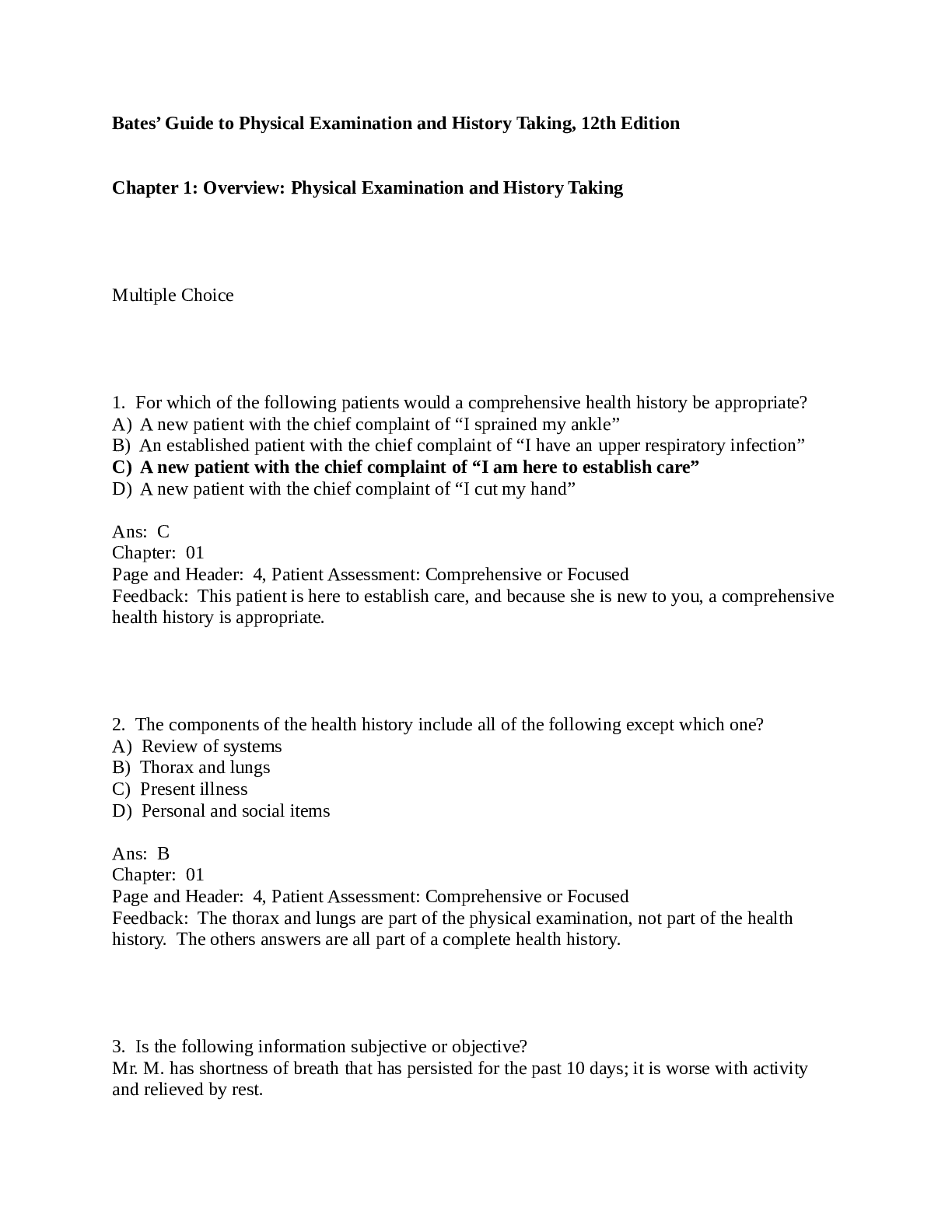

.png)
.png)
.png)

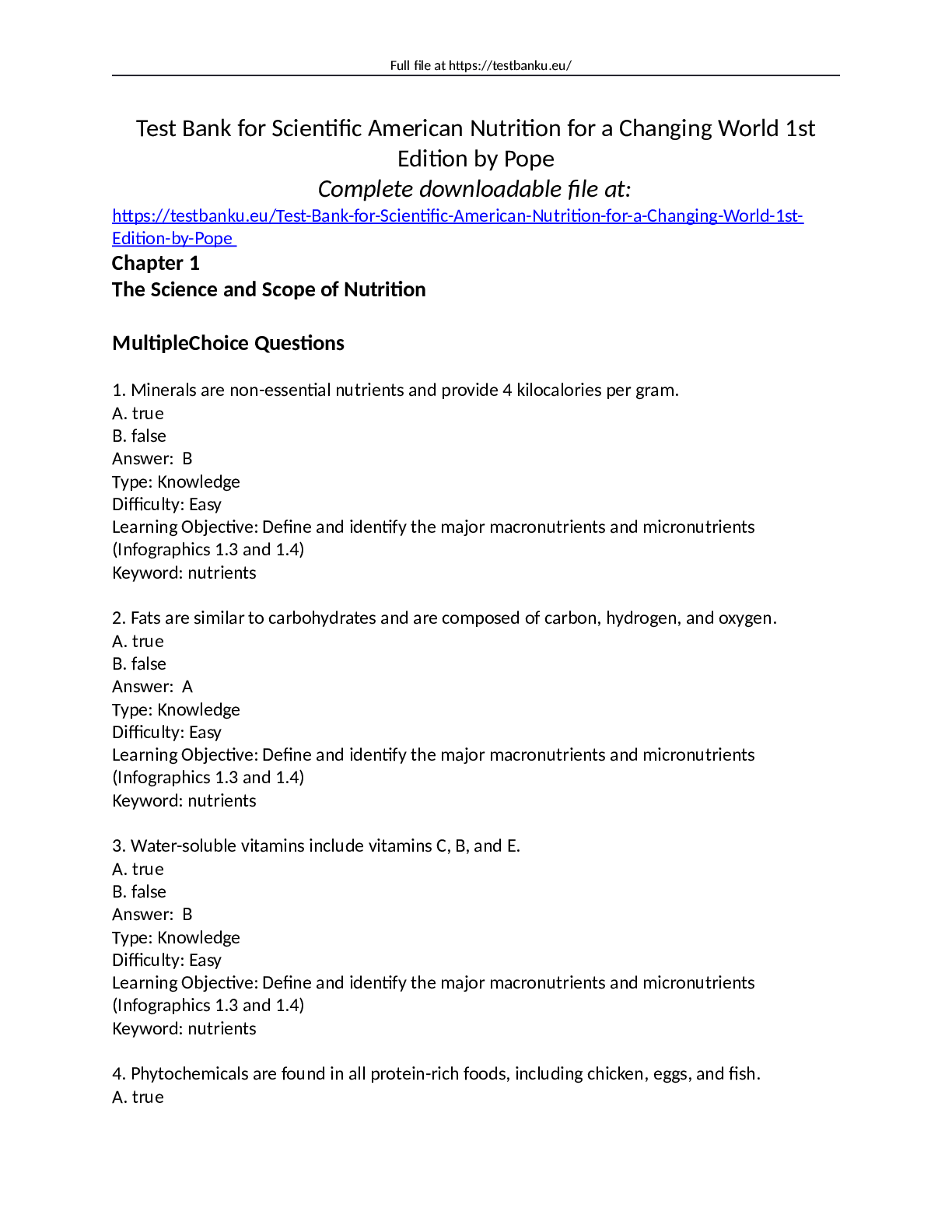
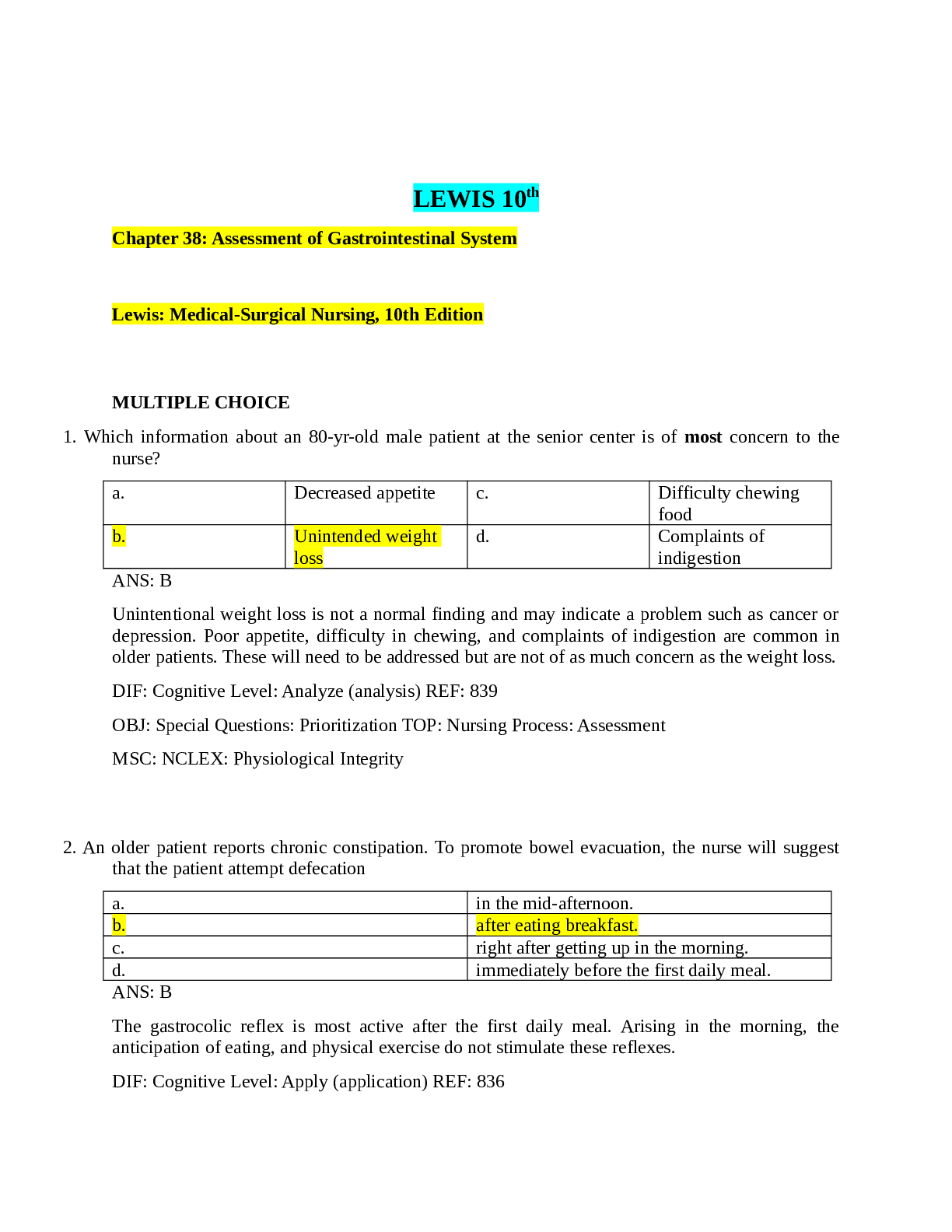

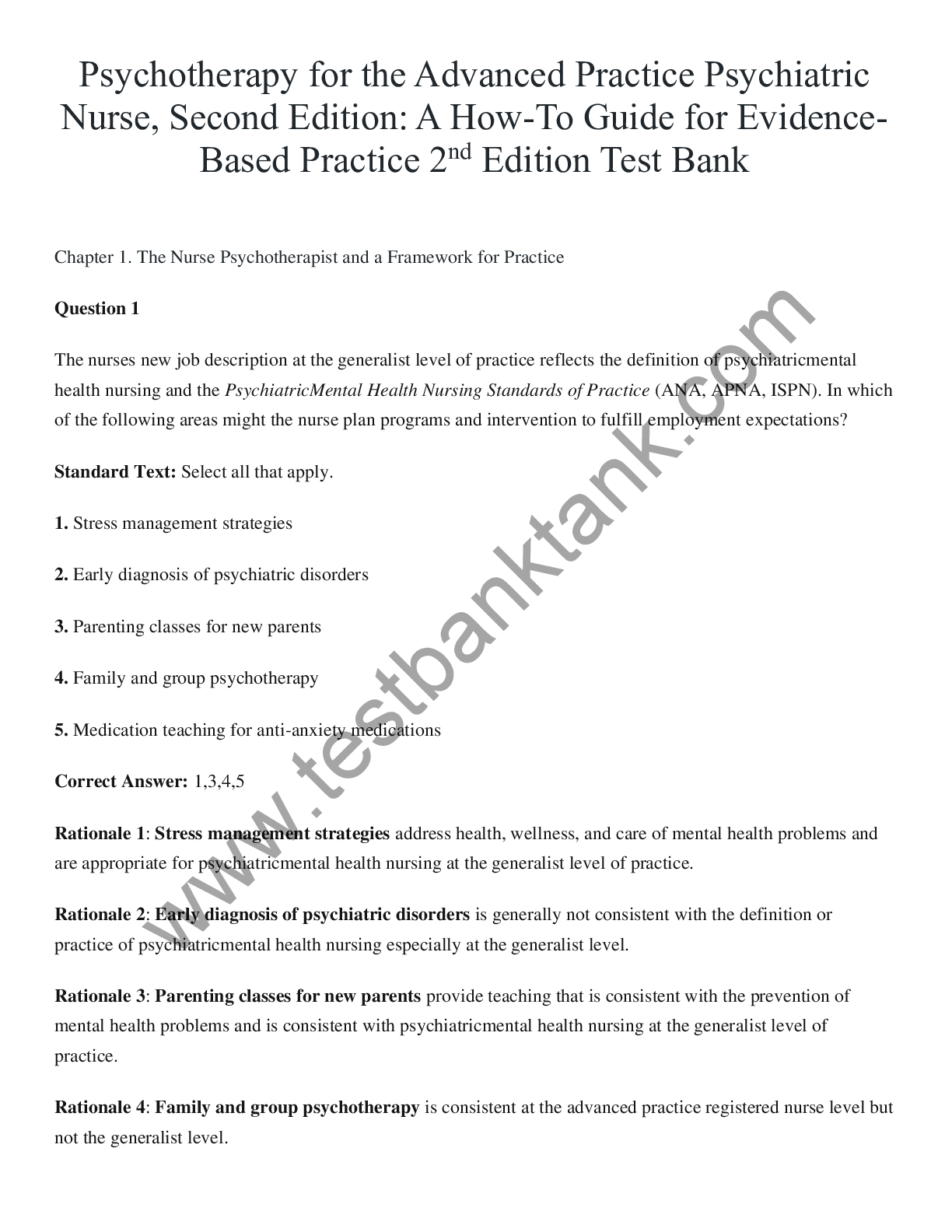
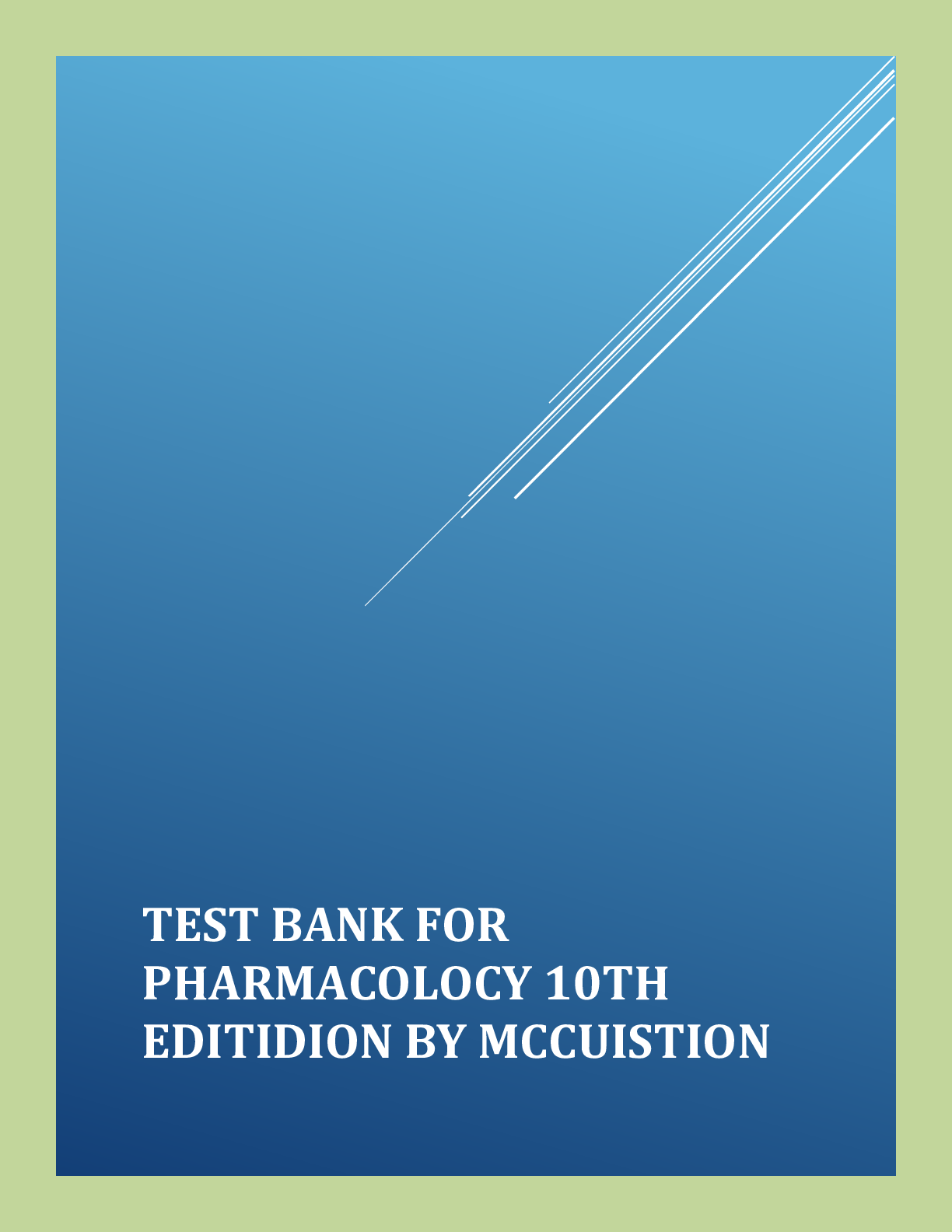
.png)




